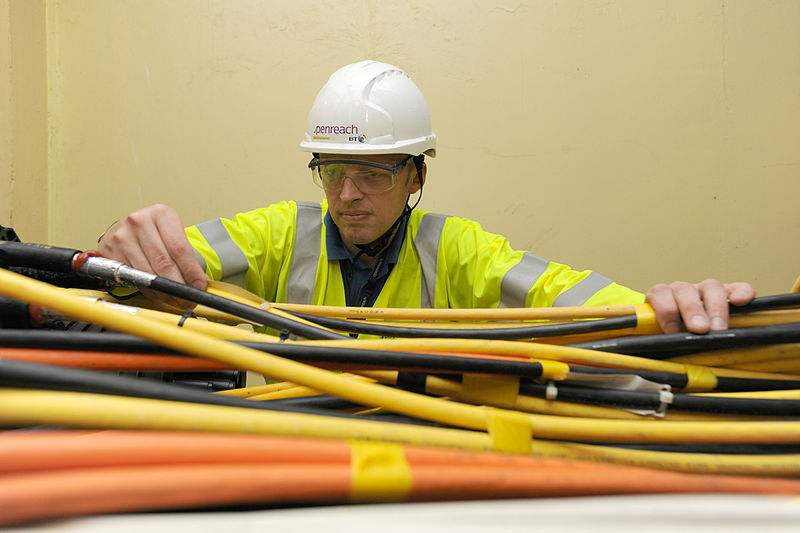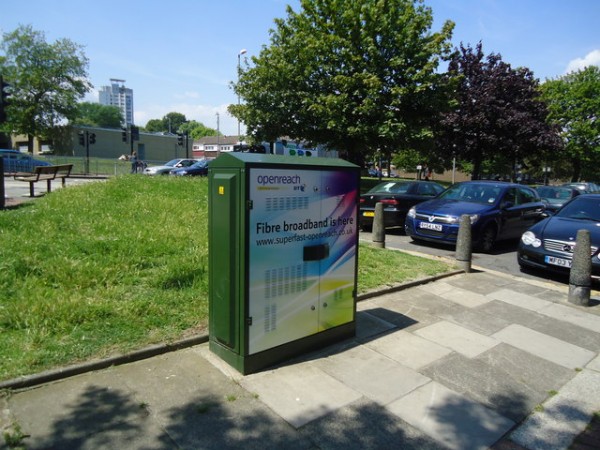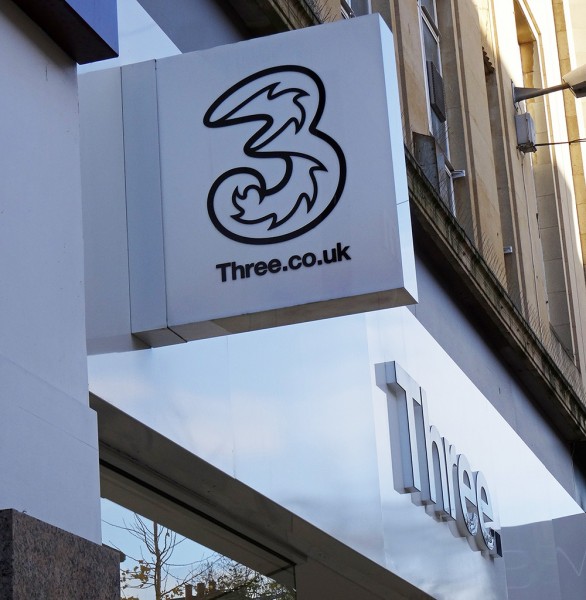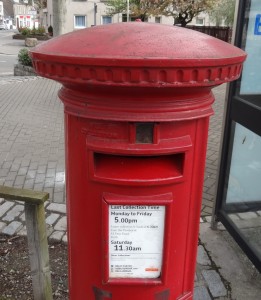 Concerns have been expressed about the UK’s relatively poor record of upgrading broadband services so that households can receive ultrafast connectivity. Some commenters have argued that future economic growth prospects will be harmed if the UK continues to lag behind its leading rivals.
Concerns have been expressed about the UK’s relatively poor record of upgrading broadband services so that households can receive ultrafast connectivity. Some commenters have argued that future economic growth prospects will be harmed if the UK continues to lag behind its leading rivals.
Much of the fixed line system that allows people to connect to broadband was originally installed many years ago for the land-line telephone network. The so called ‘final mile’ consists of copper-based wiring that is carried from street cabinets to the premises of the end-user. This wiring is transported via a huge network of telegraph poles and cable ducts (small underground tunnels).
In order for people to gain connectivity to ultrafast broadband this copper based wiring needs to be replaced by fibre optic cables. This is commonly referred to as Fibre to the Premises (FTTP). Unfortunately, the UK has a relatively poor record of installing FTTP. Japan and Korea were forecast to have 70% and 63% coverage by the end of 2015 as opposed to just 2% in the UK.
Why is the UK’s record so poor? Many observers blame it on the structure of the industry. In other network industries, such as those for gas pipeline and electricity grids, the business responsible for managing the infrastructure, National Grid, is a regulated monopoly. This company does not directly supply services to consumers using the network it is responsible for maintaining. Instead, customers are supplied by the retail sector of the industry, where firms compete for their business. This sector includes the so-called ‘big six’ (British Gas; npower; SSE; Scottish Power; EDF; E.On) and a number of smaller suppliers such as Ovo Energy and Ebico.

The structure of the fixed line telecommunications sector is very different. The company that manages the ‘final mile’, Openreach, is a subsidiary of BT. BT also competes with other Internet Service Providers (ISPs), such as TalkTalk and Sky, to supply broadband to customers using this network. Its market share of 32 per cent makes it the largest player in the broadband market. Sky and TalkTalk have market shares of 22 per cent and 14 per cent respectively. Virgin Media also supplies 20 per cent of this market using its own network of ducts and cables.
Given that in most cases ISPs such as Sky and TalkTalk are stuck with the network Openreach provides, BT may have limited incentives to invest. It can still earn a good return from its infrastructure of copper-based wiring and avoid installing expensive FTTP. Dido Harding, the chief executive of TalkTalk, argued that:
“We need to separate Openreach from the rest of BT to create a more competitive, pro-investment market”
Ofcom, in its recent review of the market, has taken a different approach. Rather than creating an entirely separate monopoly business to manage the network (i.e. splitting Openreach from BT), the regulator instead opted for a policy of encouraging competition between different suppliers that deploy fibre optic cables. It states in the report that:
“We believe competition between different networks is the best way to drive investment in high-quality, innovative services for customers.”
This competition could come from ISPs such as TalkTalk and Sky or other smaller network providers such as CityFibre and Gigaclear.
One major problem with this approach is that potential new entrants might be deterred from entering the market because of the very high initial costs involved in building a new network in order to deploy FTTP. In particular, the costs of digging up the roads and laying the ducts are considerable. Matt Yardley, author of a study on the industry, said:
“It is widely accepted that civil works such as digging trenches account for up to 80% of broadband deployment costs.”
One way of reducing these costs and encouraging more competition is to allow rival firms access to the existing ducts and poles that are currently managed by Openreach. Once access has been obtained, these firms could effectively rent space inside the ducts and lay fibre optic cables alongside the existing copper-based wiring. Vodafone reported that a similar policy in Spain had reduced its capital expenditure of building FTTP by 40 per cent compared with constructing its own network of ducts and poles.
Ofcom first introduced this type of policy in 2010 when it launched its Physical Infrastructure Access (PIA) initiative. Unfortunately it has proved to be relatively unsuccessful with very little demand for PIA from rival firms. The success of this type of policy will depend on a number of factors including (1) the prices charged by Openreach to access and rent space inside the ducts; (2) the simplicity of any relevant administration; and (3) the availability and reliability of information about the ducts. With this last point, key issues include:
|
|
| • |
Where they are located . |
| • |
How much space is available: i.e. is there enough space for firms to lay fibre optic cables alongside the existing wiring? |
| • |
What condition they are in: i.e. are they flooded or clogged up with sand and mud, which will involve expensive work to make them usable again?
|
Firms did complain about the pricing structures and bureaucratic nature of the administration process under the PIA scheme. However, their most significant concerns were about the uncertainty that was created by the lack of information about the ducts and poles. For example, analysts from the consultancy firm, Reburn, argued that if a firm contacted Openreach to try to obtain access to the network it was informed that:
“We don’t know what condition the ducts and poles are in. Please pay £10 000 for a survey. Also unfortunately we are rather busy and we can only start in six weeks.”
Matthew Hare, the chief executive of Gigaclear, argued that it was like going to a shop where the assistant says:
“Give me some money, and I’ll tell you whether you can have it or not.”
In response to these criticisms Ofcom has introduced a number of changes to PIA, which has been re-named Duct and Pole Access (DPA). In particular, it has imposed a new requirement on Openreach to create a database that provides information on the location, condition and capacity of its ducts and poles. The database must be made available to rival ISPs and network providers. DPA must also be provided on the same timescales, terms and conditions to all businesses including other parts of BT – this is referred to as ‘equivalence of inputs’.
The first big test of this policy is in Southend where City Fibre is hoping to deploy 50km of fibre optic cables using DPA. However, reports in the media have suggested that the initial surveys have found very limited capacity in some of the ducts, which would make DPA impossible.
It will be interesting to see how the trial in Southend progresses. If it is successful, then DPA may be viable for about 40 per cent of premises in the UK. If it fails, then Ofcom might ultimately have to force Openreach to be completely separated from BT.
Articles
How the gothic city of York became a broadband battleground The Telegraph, Kate Palmer (22/5/16)
City Fibre first to mount BT challenge after Openreach is told to share network The Telegraph, Kate Palmer (1/3/16)
Challenges as CityFibre Moot Using BT Cable Ducts in Southend-on-Sea ISPreview, Mark Jackson (2/5/16)
CityFibre to build pure fibre infrastructure for Southend Networking (5/4/16)
Ofcom tells BT to open up infrastructure to rivals The Guardian, Rob Davies (26/2/16)
Questions
- Draw an average total cost curve to illustrate the economics of building a network of ducts and poles. Label the minimum efficient scale.
- To what extent does DPA create a contestable market?
- For DPA to deliver productive efficiency, what must be true about the economies of scale of laying fibre optic cables?
- In the run-up to Ofcom’s review of the telecoms industry, many commentators described Openreach as being a natural monopoly. To what extent do you agree with this argument?
- What are the advantages of marginal cost pricing? What issues might a regulator face if it tried to impose marginal cost pricing on a natural monopoly?
- Using a diagram, explain how the network of ducts and poles might be a natural monopoly in rural areas but not in densely populated urban areas.
- Discuss how Ofcom has tried to increase the level of separation between Openreach and BT.
 The government plans to improve broadband access across the country and BT is a key company within this agenda. However, one of the problems with BT concerns its natural monopoly over the cable network and the fact that this restricts competition and hence might prevent the planned improvements.
The government plans to improve broadband access across the country and BT is a key company within this agenda. However, one of the problems with BT concerns its natural monopoly over the cable network and the fact that this restricts competition and hence might prevent the planned improvements.
Ofcom, the communications watchdog has now said that BT must open up its cable network, making it easier for other companies to access. This will allow companies such as Sky, Vodafone and TalkTalk to invest in the internet network in the UK, addressing their criticisms that BT has under-invested in Openreach and this is preventing universal access to decent and affordable broadband. There have been calls for Ofcom to require BT and Openreach to separate, but Ofcom’s report hasn’t required this, though has noted that it ‘remains an option’.
BT has been criticised as relying on old cables that are not sufficient to provide the superfast broadband that the government wants. The report may come as a relief to BT who had perhaps expected that Ofcom might require it to sell its Openreach operation, but it will also remain concerned about Ofcom’s constant monitoring in the years to come. BT commented:
“Openreach is already one of the most heavily regulated businesses in the world but we have volunteered to accept tighter regulation … We are happy to let other companies use our ducts and poles if they are genuinely keen to invest very large sums as we have done.”
 Its rivals will also be in two minds about the report, happy that some action will be taken, but wanting more, as Ofcom’s report suggests that “Openreach still has an incentive to make decisions in the interests of BT, rather than BT’s competitors”. A spokesperson for Vodafone said:
Its rivals will also be in two minds about the report, happy that some action will be taken, but wanting more, as Ofcom’s report suggests that “Openreach still has an incentive to make decisions in the interests of BT, rather than BT’s competitors”. A spokesperson for Vodafone said:
“BT still remains a monopoly provider with a regulated business running at a 28% profit margin …We urge Ofcom to ensure BT reinvests the £4bn in excess profits Openreach has generated over the last decade in bringing fibre to millions of premises across the country, and not just make half-promises to spend an unsubstantiated amount on more old copper cable.”
The impact of Ofcom’s report on the competitiveness of this market will be seen over the coming years and with a freer market, we might expect prices to come down and see improved broadband coverage across the UK. In order to achieve the government’s objective with regards to broadband coverage, a significant investment is needed in the network. With BT having to relinquish its monopoly power and the market becoming more competitive, this may be the first step towards universal access to superfast broadband. The following articles consider this report and its implications.
Ofcom opens a road to faster broadband The Guardian, Harriet Meyer and Rob Davies (28/2/16)
Ofcom: BT must open up its Openreach network Sky News (25/2/16)
How Ofcom’s review of BT Openreach could improve your internet service Independent, Doug Bolton (25/2/16)
Ofcom’s digital review boosts faltering broadband network Financial Times, Daniel Thomas (25/2/16)
The Observer view on broadband speeds in Britain The Observer, Editorial (28/2/16)
Ofcom tells BT to open up cable network to rivals’ BBC News (25/2/16)
Ofcom should go further and break up BT Financial Times, John Gapper (25/2/16)
BT escapes forced Openreach spin-off but Ofcom tightens regulations International Business Times, Bauke Schram (25/2/16)
Questions
- Why does BT have a monopoly and how might this affect the price, output and profits in this market?
- Ofcom’s report suggests that the market must be opened up and this would increase competitiveness. How is this expected to work?
- What are the benefits and costs of using regulation in a case such as this, as opposed to some other form of intervention?
- How might a more competitive market increase investment in this market?
- If the market does become more competitive, what be the likely consequences for consumers and firms?
 There have been a number of recent developments in communications markets that may significantly alter the competitive landscape. First, the UK Competition and Markets Authority (CMA) has provisionally cleared BT to takeover the EE mobile phone network. The deal will allow BT to re-establish itself as a mobile network provider, having previously owned O2 until it was sold in 2005. The CMA said that:
There have been a number of recent developments in communications markets that may significantly alter the competitive landscape. First, the UK Competition and Markets Authority (CMA) has provisionally cleared BT to takeover the EE mobile phone network. The deal will allow BT to re-establish itself as a mobile network provider, having previously owned O2 until it was sold in 2005. The CMA said that:
They operate largely in separate areas with BT strong in supplying fixed communications services (voice, broadband and pay TV), EE strong in supplying mobile communications services, and limited overlap between them in both categories of service.
BT will therefore be in a better position to compete with rivals such as Virgin Media who were early movers in offering.  Second, O2 itself (currently owned by Telefónica) is the subject of a takeover bid from Hutchinson Whampoa who already owns the mobile network Three. Because the companies meet their turnover criteria, this deal is being investigated by the European Commission (EC) and the signs don’t look good. If it goes ahead, it would create the largest mobile operator in the UK and leave just three main players in the market. The EC is concerned that the merger would lead to higher prices, reduced innovation and lower investment in networks. Previously, considerable consolidation in telecommunications markets across Europe has been allowed. However, recent evidence, including the prevention of a similar deal in Denmark, suggests the EC is starting to take a tougher stance.
Second, O2 itself (currently owned by Telefónica) is the subject of a takeover bid from Hutchinson Whampoa who already owns the mobile network Three. Because the companies meet their turnover criteria, this deal is being investigated by the European Commission (EC) and the signs don’t look good. If it goes ahead, it would create the largest mobile operator in the UK and leave just three main players in the market. The EC is concerned that the merger would lead to higher prices, reduced innovation and lower investment in networks. Previously, considerable consolidation in telecommunications markets across Europe has been allowed. However, recent evidence, including the prevention of a similar deal in Denmark, suggests the EC is starting to take a tougher stance.
If we compare the two proposed takeovers, it is clear that the O2–Three merger raises more concerns for the mobile communications market because they are both already established network providers.  However, it is increasingly questionable whether looking at this market in isolation is appropriate. As communication services become increasingly intertwined and quad-play competition becomes more prevalent, a wider perspective becomes more appropriate. Once this is taken, the BT–EE deal may raise different, but still important, concerns.
However, it is increasingly questionable whether looking at this market in isolation is appropriate. As communication services become increasingly intertwined and quad-play competition becomes more prevalent, a wider perspective becomes more appropriate. Once this is taken, the BT–EE deal may raise different, but still important, concerns.
Finally, the UK’s communications regulator, OFCOM, is currently undertaking a review of the whole telecommunications market. It is evident that their review will recognise the increased connections between communications markets as they have made clear that they will:
 examine converging media services – offered over different platforms, or as a ‘bundle’ by the same operator. For example, telecoms services are increasingly sold to consumers in the form of bundles, sometimes with broadcasting content; this can offer consumer benefits, but may also present risks to competition.
examine converging media services – offered over different platforms, or as a ‘bundle’ by the same operator. For example, telecoms services are increasingly sold to consumers in the form of bundles, sometimes with broadcasting content; this can offer consumer benefits, but may also present risks to competition.
One particular concern appears to be BT’s internet broadband network, Openreach. This follows complaints from competitors such as BSkyB who pay to use BT’s network. Their concerns include long installation times for their customers and BT’s lack of investment in the network. One possibility being considered is breaking up BT with the forced sale of its broadband network.
It will be fascinating to see how these communications markets develop over time.
BT takeover of EE given provisional clearance by competition watchdog The Guardian, Jasper Jackson (28/10/15)
Ofcom casts doubt on O2/Three merger BBC News, Chris Johnston (08/10/15)
BT and Openreach broadband service could be split in Ofcom review The Guardian, John Plunkett (16/07/15)
Questions
- What are the key features of communications markets? Explain how these markets have developed over the last few decades.
- What are the pros and cons for consumers of being able to buy a quad-play bundle of services?
- How do you think firms that are currently focused on providing mobile phone services will need to change their strategies in the future?
- Why is BT in a powerful position as one of the only owners of a broadband network?
- Instead of forcing BT to sell its broadband network, what other solutions might there be?
 46p – that buys you a First Class stamp. However, the price will now rise to 60p and the price of a Second Class stamp will increase to 50p from 36p, as Ofcom lifts some price caps. These significant price rises have seen shortages of stamps emerging across the country. As people anticipate the price rise, individuals and businesses are buying up stamps while they remain relatively cheap.
46p – that buys you a First Class stamp. However, the price will now rise to 60p and the price of a Second Class stamp will increase to 50p from 36p, as Ofcom lifts some price caps. These significant price rises have seen shortages of stamps emerging across the country. As people anticipate the price rise, individuals and businesses are buying up stamps while they remain relatively cheap.
The problem is that this has started to result in a stamp shortage, so much so that the Royal Mail has now begun rationing retailers’ supply of stamps, capping each retailers’ supply this month to 20% of its annual allocation. A Royal Mail spokesman said:
“We are more than happy for retailers to receive the normal commercial return they obtain on stamps and no more than that … That is why we have put in place a prudent allocation policy to safeguard Royal Mail’s revenues and ensure there are more than enough stamps for people to buy both now and in the future.”
With postage volumes falling, as individuals turn to other methods of communication, Royal Mail says that this price rise is essential to keep this universal service going. Revenues have been low and the Royal Mail has been loss-making for some time.
However, while the price rise may help the Royal Mail, many businesses may suffer in its place. One optician, who sends out approximately 5,000 reminders to patients each year intends to bulk-buy 10,000 stamps in the hopes of saving some £1,400 when prices of stamps rise. An IT worker bought 20 books of 12 first-class stamps and said ‘If I could afford it, I would buy a lot more’. Many are unhappy at the ‘shameless profiteering at the public’s expense’, but whatever your opinion about the price rise, it does make for an interesting case of demand and supply. The following articles consider this stamp shortage.
Man’s 10,000 stamp panic: stampede for stamps leaves a 1st class mess as Royal Mail introduces rationing ahead of 30% price rise Mail Online, Colin Fernandez and John Stevens (15/4/12)
Stamps rationed by Royal Mail in run up to price rise (including video) BBC News (13/4/12)
Stamp rationing could hit pensioners Telegraph, James Hall (14/3/12)
Stamp sales limited ahead of price hike Sky News (13/4/12)
How stamp collecting came unstuck Guardian, Hunter Davies (13/4/12)
Royal Mail limits supply of stamps ahead of price rise Telegraph, James Hall and Andrew Hough (12/4/12)
’Profiteering’ Royal Mail limits supply of stamps before price rise Guardian, David Batty (13/4/12)
Royal Mail’s stamp price rises come into force BBC News (30/4/12)
How businesses will be affected by Royal Mail’s changing prices BBC News, Catherine Burns (28/4/12)
Questions
- If people expect prices to rise, what will happen to the demand curve? Illustrate this idea on a demand and supply diagram?
- If suppliers anticipate a price rise, what would their best strategy be?
- On a demand and supply diagram, illustrate the shortage of stamps that has emerged. If left to the free market, what should happen to the price of stamps?
- Why could pensioners and those in rural areas be the most adversely affected by this shortage and price rise?
- Why could ‘children and new collectors’ be priced out of the market?
- Why will small businesses be affected by this price hike? How could their customers be affected?
With news of the economy contracting in the previous quarter, it was perhaps a surprise to some that BSkyB has seen growth in its customer numbers to above 10 million: much of this increase due to growth in broadband numbers. In the second half of 2010, BSkyB reported that revenues increased by 15% to £3.2bn and their pre-tax profits were also on the way up to £467m. These latest figures are likely to put increasing pressure on News Corp’s takeover bid for the shares they do not own in BSkyB (61%), as share prices increase by 2%. Last summer, a bid of 700p per share was rejected and while both companies did agree to work together to determine if a future merger was viable, these higher share prices put BSkyB in a much stronger position.
However, before anything else happens, Rupert Murdoch’s company is waiting for regulatory approval from Ofcom for this takeover. BBC reports sugges that Ofcom has made an:
“unambiguous recommendation that News Corp’s plan to acquire all of BSkyB should be referred to the Competition Commission for further investigation.”
The Culture Secretary, Jeremy Hunt, has spoken of his intention to refer this potential merger to the Competition Commission, following Ofcom’s recommendation. There are concerns about the impact on competition and Rupert Murdochs’ increased influence over public opinion, if this merger were to go ahead. Any delays in finalizing a deal could benefit BSkyB, if their financial performance continues. Analysts suggest that the delay could be 6 months, while any investigation takes place. If profits continue to rise, share prices may also go up, requiring higher and higher bids by News Corp. Watch this space!
BSkyB profits soar 26% to £520m putting pressure on NewsCorp to increase takeover bid Daily Mail (27/1/11)
BSkyB reports big jump in profits BBC News (27/1/11)
BSkyB spends £7m on News Corp bid Guardian, Mark Sweney (27/1/11)
BSkyB result to highlight pressure on News Corp Reuters, Kate Holton (26/1/11)
HD TV, broad demand boosts BSkyB Telegraph (27/1/11)
News Corp bud for Sky should go to Competition Commission, recommends Ofcom Telegraph (27/1/11)
Call off the hunt Financial Times (20/1/11)
Numis raises BSkyB on expected News Corp deal delay Reuters (21/1/11)
Questions
- Explain what type of merger it would be between News Corp and BSkyB.
- What are the arguments (a) for the merger and (b) against the merger? Consider the impact on the public, the competitors, the workers etc.
- What is the role of Ofcom and the Competition Commission? How do their responsibilities differ?
- As demand for Sky’s products increases, what could we expect to see in terms of price? Now explain why your answer may not happen!
- Why have BSkyB’s share prices been affected? Is it the demand of supply of shares that has changed? Illustrate your answer on a diagram.
 Concerns have been expressed about the UK’s relatively poor record of upgrading broadband services so that households can receive ultrafast connectivity. Some commenters have argued that future economic growth prospects will be harmed if the UK continues to lag behind its leading rivals.
Concerns have been expressed about the UK’s relatively poor record of upgrading broadband services so that households can receive ultrafast connectivity. Some commenters have argued that future economic growth prospects will be harmed if the UK continues to lag behind its leading rivals.






